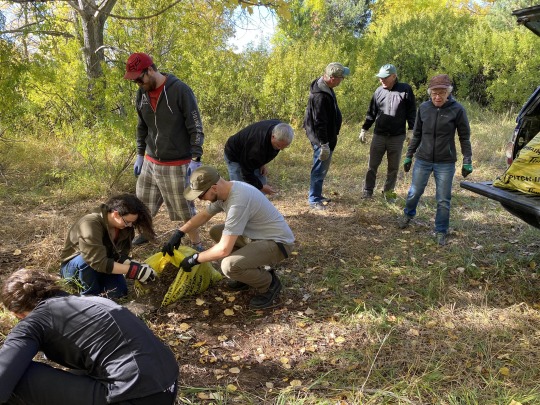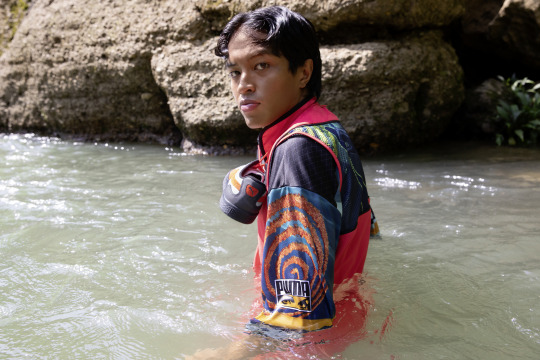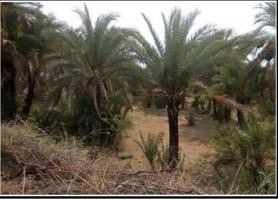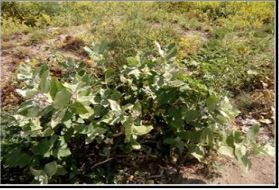#biodiversity prevail
Explore tagged Tumblr posts
Text
Saskatoon's Response to Plastics Menace
“Earth Day 2024: Planet vs. Plastics – A Call to Action for Environmental Protection“ Article: Earth Day, observed annually on April 22, is a global initiative rallying individuals to demonstrate their support for environmental protection. This year’s theme, “Planet vs. Plastics,” emphasizes the urgent need to address the detrimental impact of plastics and microplastics on our planet’s…

View On WordPress
#2024#advocacy#April 26 – April 29#biodiversity#biodiversity guardians#Biodiversity Inventory#biodiversity prevail#birds#Citizen Science#City Nature Challenge#city of bridges#city of change#combatting plastics#conscious living#conservation#Conservation Efforts#discovery#document biodiversity#early detection#Earth day#Earth Day initiatives#Earth Day theme#Earth&039;s battle cry#Earth&039;s defenders#Earth&039;s guardians#Earth&039;s resilience#Earth&039;s SOS#Earth&039;s well-being#eco-awareness#eco-conscious
0 notes
Text
The Blindspot of Contemporary Mission

I want to highlight one massive “blind spot” concerning mission which prevails in many churches...
We seem to have forgotten that the primary way the church impacts the world is not through its programmes, or by multiplying religious professionals, or starting more mission agencies and ecumenical commissions; but, rather, through the daily work of Christian men and women in offices, schools, factories, village councils, research laboratories, company board rooms, and so on. These are the contemporary sites of Christian mission.
I was in Malaysia a few months ago and I spent a memorable morning with a handful of committed Christian politicians who were MPs representing different opposition political parties in that country. They came from a variety of church traditions, including Roman Catholic and Pentecostal. I asked them “What is the biggest source of frustration you experience in your work?” I expected them to say something like “The compromises we need to make as party members”, but instead they were unanimous in their answer: “Our church”. They did not receive any support from their churches, whether in the form of regular prayer, financial assistance or volunteers to help in implementing social policies or just running their offices. One woman told me her church raised huge funds to send cross cultural missionaries and young people on short-term “mission trips” to other parts of Asia. But their work as politicians was not considered as “mission”. The only time the church leaders showed any interest in what they did was when Christians themselves suffered political harassment.
Theological education has to be re-oriented radically around the lives of “lay” people, not the agendas of clergy and mission societies.
This story is repeated all over the world. My wife and I work primarily with Christian in secular occupations, helping them to live out the Gospel and communicate God’s truth and justice in the fields of science, business, the arts, medicine, education and so on. These men and women who engage “Christianly” with the public square are at the cutting-edge of mission. They face huge ethical challenges thrown up by, say, new medical technologies or new social networking media, genetic engineering, venture capitalism and hedge funds, anti-terrorist legislation, euthanasia, climate change and biodiversity loss. These all call for deep missionary engagement and missiological reflection... But Asian mission studies dissertations and the bulk of articles in mission studies journals focus on historical studies of religious sects and denominations, traditional tribal cultures or exotic new religious movements.
It seems that we have been blinded by the neat divisions we have been drawn between theology, ethics and mission. Those boundaries need to be deconstructed. We have been reminded in recent years that all theology is mission theology, that the church does theology “on the road” and not just in the library or the pulpit. But then theological education has to be re-oriented radically around the lives of “lay” people, not the agendas of clergy and mission societies. Social and political ethics has become the locus of evangelical proclamation.
-Vinoth Ramachandra, PhD (University of London)
Source: “A Brief Reflection on Edinburgh 2010”
2 notes
·
View notes
Text
Where Should You Plant Trees for Maximum Benefits?

Planting trees isn't just about adding a touch of green to your landscape; it's like creating your own personal outdoor oasis. Trees are the unsung heroes of our environment, providing shade, improving air quality, and even boosting your property's value. But where you plant these leafy wonders can make all the difference. In this guide, we'll show you how to plant trees strategically to maximize their benefits, from creating a cool, shady retreat to blocking out those pesky winds. Let's get planting!
1. Plant Trees to Maximize Shade
Want to turn your home into a cool oasis during the scorching summer months? Planting shade trees is like installing a natural air conditioner. By strategically placing trees on the east, west, and southwest sides of your home, you can block the sun's rays and keep your indoor spaces cool and comfortable. And the best part? Deciduous trees, like those that shed their leaves in the fall, offer a two-for-one deal. They provide shade in the summer and let the sunshine in during the winter, helping you save on heating costs. It's like having a natural thermostat in your backyard!
2. Create Natural Windbreaks
Tired of battling those pesky winds? Planting trees as windbreaks is like building a natural fortress to protect your property. A strategically placed row of trees can shield your home, garden, and outdoor structures from the elements. Imagine having a cozy, wind-free retreat in your own backyard. To get the most out of your windbreak, plant them on the side of your property that faces the prevailing winds, usually the north or northwest. And for year-round protection, evergreen trees are your best bet. Plant them in staggered rows, and watch them work their magic in blocking those pesky winds. It's like having your own personal windshield!
3. Improve Energy Efficiency
Want to save some green on your energy bills? Trees aren't just for looks; they can also be your secret weapon for energy conservation. In addition to providing shade in the summer, strategically planting trees to the north or northwest of your home can act as a natural windbreak, keeping your house cozy and warm during the chilly winter months. It's like having your own personal energy-saving shield. And here's a bonus tip: planting smaller shrubs and trees close to your house can create an insulating layer of air, further enhancing your home's energy efficiency. Your trees are working harder than you think!
4. Enhance Privacy and Noise Reduction
Want to create a private oasis in your backyard? Planting trees is like building a natural fence that provides privacy and peace of mind. By strategically placing dense, fast-growing trees around your property, you can shield your outdoor spaces from prying eyes and create a more intimate atmosphere. And trees reduce noise pollution. Plant tall trees in a staggered formation near the source of the noise, and let them soak up the unwanted sounds. Evergreens are like a year-round privacy curtain, providing a thick barrier against noise and unwanted views. So, plant away and enjoy your newfound privacy!
5. Encourage Wildlife and Biodiversity
Want to create a wildlife haven in your backyard? Planting native trees is like rolling out the red carpet for your feathered and furry friends. These trees provide food and shelter for local wildlife, making your yard a nature lover's paradise. To attract birds, pollinators, and small mammals, group multiple trees together in a secluded corner of your yard. It's like building a mini wildlife sanctuary!
Just a friendly reminder: If you're inviting wildlife into your backyard, avoid planting trees too close to your home or driveway. Falling leaves and animal activity can be a bit messy, so choose a spot that's away from high-traffic areas. Let your wildlife guests enjoy their natural habitat without causing any inconveniences.
6. Consider Soil and Drainage Conditions
Before you start planting, it's important to understand your soil's personality. Some trees prefer moist, soggy soil, while others are more drought-tolerant. It's like finding the perfect roommate for your yard! To figure out your soil's preferences, you can test it yourself or consult with a local expert in tree care service in Portland, Oregon. They’ll be able to recommend tree species that will thrive in your specific conditions, ensuring your trees have a happy and healthy home.
7. Avoid Planting Too Close to Structures
Think of your trees like your neighbors. You want them to be friendly and harmonious, but not too close for comfort. Planting trees too close to your home, driveway, or underground utilities can lead to some serious drama. As trees grow, their roots can become invasive, causing damage to foundations, plumbing, or sidewalks. It's like having a neighbor who digs up your garden or accidentally cuts your power.
To avoid any tree-related conflicts, make sure to plant large trees at least 15-20 feet away from your home and structures. And always look up before you plant! Trees that grow too tall can become a safety hazard, so be mindful of overhead power lines. Let's keep the peace in your neighborhood and avoid any tree-related drama.
Final Thoughts
Planting trees is like creating a masterpiece in your backyard. It's not just about choosing the right colors (or tree species), but also about placing them strategically. Think of your trees as pieces of a puzzle, each with a unique role to play. By considering factors like sunlight, wind direction, soil conditions, and proximity to structures, you can create a harmonious landscape that benefits you in countless ways.
If you're feeling overwhelmed by all the choices, don't hesitate to consult with a local certified arborist. They're like tree whisperers, with expert knowledge of the best species and placements for your specific landscape. With their guidance, you can create a thriving garden that will bring joy and beauty to your home for years to come.
2 notes
·
View notes
Text

Elizabeth Woodger : Crimson flourish, 2024
Many of the lichens growing in Exmoor’s temperate rainforests are globally scarce, and some are important indicators of air quality and habitat biodiversity. The series Arborea takes windfall lichens from these ancient woodlands and soaks them in a chemical solution until crystals form. This artistic experiment mimics the prevailing ecological crises; where human actions are influencing geological processes with unpredictable consequences.
In this photograph numerous small crystals punctuate the surface of a fruticose lichen growing on a tree branch | Guardian Newspaper #lichen
4 notes
·
View notes
Note
my query: Hi! I was wondering about your thoughts on pesticides and herbicides!
(I fucking despise them, they are literally commercial poison. fuck pesticides and herbicides and their use in stupid things like getting rid of native weeds and animals.)
because I'd love to hear your thoughts on them!
-belle
whenever the subject of pesticides and herbicides comes up, my thought is what happens when the soil that is being relied upon to grow our food begins to degrade due to these chemicals? the reality is that is already happening.
our soil holds a quarter of our entire planet’s biodiversity and should demand a level of protection that reflects that fact. the prevailing narrative on pesticide regulation presents a facade of safety and control. but unfortunately a deeper look shows the negligence we’ve grown to expect from our leaders on nearly every subject.
an independent review of nearly 400 published studies containing more than 2,800 experiments that described the impact of pesticides on soil organisms showed that over 70 percent of the experiments gave proof to pesticides inflicting harm on critical soil organisms.
but the information the EPA is using to evaluate the harm of pesticides on the environment and wildlife is not nearly as thorough or complete.
for example: despite the EPA’s acknowledgment that up to 100 percent of agriculturally applied pesticides find their way to the soil, their assessment of harm relies on a single test species — the European honeybee — which spends its life aboveground in artificial confines, to gauge the risk to all soil organisms.
the sheer, sweet irony that a fucking species with no natural connection to soil is used to represent the essence of our underground ecosystem is *chefs kiss*
this practice exposes a system that seems predictably more willing and designed to protect the chemical and pesticide industry rather than the species’ that live underneath our feet that we rely upon.
what we’re ultimately left with is yet another disturbing insight into capitalist regulatory mechanisms - a system that simply grants permissions to industry without pausing to consider the impacts their business may have on the planet and the people who live on it.
11 notes
·
View notes
Text
What causes heat waves from the atmospheric layer?

Heat waves are simply defined as high humidity and dry tropical conditions occurring due to ocean & severe climatic-induced changes in the places of the world.
When temperature increases continuously in the range of 5 days, the heat waves or dry conditions with high humidity form in the atmospheric pressure.
However, defining - the sun can influence only the earth’s climatic condition and variations but never hold the responsibility for the causes of global warming happening on the planet. Causing biodiversity and ecosystem chaos is becoming a major concern for WHO & MHW.
On the probability account for heat waves, it is caused - When the Jet streams are in the situation of meandering, a set of broad waves tends to be formed in the form of crests and troughs over the northern and southern regions for roughly up to 100 kilometers. And significantly the jet streams that are formed in the northern and southern terrestrial hemispheres are undulated more in the period of their summer. Due to the earth’s axial forming tilts, the polar region receives more light in summers, they have a propensity for weakening the temperature in contrast to the tropics. And proceeding waves become severely amplified, high, and low pressure systems at crests and troughs. Leaving these high pressure stuck over a place/ spot for over a day or weeks causing severe heat waves adjoined with high humidity prevailing conditions in the particular region.
In terms of concern for economic issues, extreme heat can increase the risk of other types of disasters. Heat has the ability to exacerbate drought, hot and, dry humid conditions which turn and create wildfires.
2 notes
·
View notes
Text
PUMA x P.A.M. Collection

PUMA and Australian independent cult brand Perks and Mini (P.A.M.) present the second installment of the the PAM/PUMA BIO/VERSE project. Spanning four seasons, the PAM/PUMA BIO/VERSE initiative pushes the limits of PUMA’s creative partnerships. This latest installment introduces a collection of technical sportswear infused with the “psy-active” energy Perks and Mini is known for.
For this season the campaign aims to bring to life one of the key themes behind the collaboration: the continued exploration of our biodiverse world. Set in the jungles of North Sumatra, the campaign is an expedition into one of the last remaining wild places. Thaiboy Digital and his paramour Cartoon explore and pay tribute to the beauty and diversity of the jungle as they uncover its hidden portals. The campaign is brought to life with a cast of storytellers, creatives, environmental and data scientists, rangers, and conservationists, who come together to honor this sacred place.
To gear up for their expedition, PUMA and P.A.M. have created a collection of technical silhouettes that are outfitted with light, airy graphics, trail-inspired details, and functional utility throughout. Items like the Zip-Off Jacket, Reversible Cap, and Woven Pants all channel a sense of outdoor exploration, while playful graphics keep the collection rooted in Perks and Mini’s visual DNA. Appearing throughout the collection, PUMA and Perks and Mini also introduce a special wordmark featuring the logos of both brands.
The collaboration also serves new takes on the Prevail TRL, Clyde Rubber, and Trinomic Sandal. With bold color blocking and high-vis hits on the trim and laces, the trio of footwear styles is a fresh new look for three of PUMA’s summer-ready silhouettes.
The PUMA x P.A.M. collection is available April 29, 2023 at PUMA flagship stores, PUMA.com, P.A.M. stores, PERKSANDMINI.com, and distribution partners with retail prices ranging from $40-$250.





























2 notes
·
View notes
Text
The Hidden Dangers of Vehicle Emissions Explained
Most people think of vehicles in terms of convenience, speed, and mobility. But beneath the sleek design and roaring engines lies an often-overlooked concern — emissions. Every car on the road produces gases and particles that don’t just disappear into the air harmlessly. These emissions, especially in high-traffic urban areas, can contribute to significant health and environmental challenges.
In 2025, while governments worldwide advocate for cleaner energy and transportation, Australia is also confronting the challenge of vehicle emissions. From air pollution to its impact on climate change, recognizing the concealed risks of these emissions has become essential — not only for environmental sustainability but also for public health.
Let’s examine five significant reasons why vehicle emissions warrant more focus than they presently attain.
1. Vehicle Emissions Are a Major Source of Air Pollution
Vehicles such as cars, trucks, SUVs, and motorcycles emit a variety of pollutants into the air. This encompasses nitrogen oxides (NOx), hydrocarbons, particulate matter (PM), and carbon monoxide (CO) — each of which has immediate health impacts on both humans and animals.
As these pollutants accumulate in the atmosphere, particularly in urban areas with heavy traffic, they aid in the development of smog. This haze diminishes air quality, restricts visibility, and can persist in the atmosphere for hours or even days, especially in regions with low wind or valleys.
Even with progress in cleaner engine technology, countless older or inadequately maintained vehicles continue to release harmful pollution, exacerbating existing air quality issues.
2. Health and Environmental Impacts Are Growing Concerns
One of the most concerning effects of vehicle emissions is their direct connection to human health problems. Research has consistently indicated that extended exposure to air pollution from vehicle emissions raises the likelihood of:
Respiratory problems, such as asthma and chronic bronchitis
Heart disease, due to the impact of pollutants on the cardiovascular system
Cancer, especially from long-term exposure to carcinogenic compounds like benzene and diesel exhaust
Certain groups are especially at risk. Children, unborn babies, and elderly people living near busy roads are more vulnerable to the long-term health effects of vehicle emissions. In some cases, simply walking along a congested street during peak hours can expose individuals to harmful levels of pollutants.
Environmentally, the effects are just as troubling. Exhaust fumes contribute to acid rain, ground-level ozone, and long-term soil and water contamination. These can degrade ecosystems, kill sensitive plants, and reduce biodiversity in already threatened areas.
3. Greenhouse Gases Fuel Climate Change
Although local air pollution impacts our immediate environment, emissions from vehicles also contribute greatly to global climate change. The primary greenhouse gas released by vehicles is carbon dioxide (CO2), which is a direct result of fossil fuel combustion.
When CO2 and other greenhouse gases build up in the atmosphere, they retain heat and interfere with natural climate systems. The outcome? Increasingly severe weather incidents, elevated global temperatures, and changes in weather trends impacting agriculture, water resources, and public safety.
Transportation contributes approximately 20% of total global CO2 emissions, and Australia is included in this statistic. In spite of initiatives to reduce emissions using electric vehicles (EVs) and cleaner fuels, internal combustion engine vehicles still prevail on Australian roads.
Cutting these emissions necessitates not only personal accountability but also modifications in policy and the broad implementation of cleaner technologies — such as improved exhaust system designs.
4. Many People Still Overlook the Importance of Proper Exhaust Maintenance
While many car owners recognize the necessity of routine oil changes and tire rotations, fewer appreciate the significance of keeping an efficient and clean exhaust system. A defective exhaust not only hampers performance but can significantly elevate a vehicle's emissions levels.
Issues such as blocked catalytic converters, leaking exhaust pipes, or faulty mufflers frequently remain unnoticed until a vehicle either fails an inspection or shows clear performance problems. In the interim, the vehicle might be quietly emitting significantly more pollution than it is supposed to.
Modern exhaust systems include components like:
Catalytic converters, which reduce harmful gases
Diesel particulate filters (DPFs), which trap soot in diesel engines
Oxygen sensors, which monitor fuel-to-air ratios
When any of these parts malfunction, emissions rise. Regular maintenance and choosing high-quality replacement parts is key to keeping a vehicle road-legal and eco-friendly.
5. Awareness and Action Are the First Steps Toward Cleaner Roads
The positive development is that consciousness regarding vehicle emissions is gradually growing in Australia. As new regulations are implemented in various states, drivers must now comply with tougher emission standards. Regulation has also been enhanced, with officials performing roadside inspections and levying penalties for improper exhaust alterations.
An increasing number of Australians are expressing interest in low-emission vehicles, aftermarket options that fulfill emissions regulations, and efficient exhaust systems. Educational campaigns and government programs are assisting drivers in realizing that the car they operate — and how they care for it — can greatly affect the environment.
Knowledgeable choices, such as selecting emissions-compliant aftermarket components or switching to more efficient exhaust systems, are contributing to a cleaner, quieter future for all Australians.
Finding the Right Exhaust System Partner
To assist drivers in fulfilling these increasing environmental requirements, firms such as Outback Exhausts are taking on an important role. Focusing on high-quality exhaust systems for 4x4s and performance cars, they offer Australian motorists durable, dependable options designed for performance and adherence to regulations.
Outback Exhausts recognizes the importance of improving performance while adhering to legal emissions regulations. Designed for the Australian terrain and vehicle variations, they assist car owners in minimizing their ecological footprint — while still delivering the performance and sound that fans appreciate.
Whether you're hauling a caravan, traversing rough landscapes, or just enhancing your exhaust system, collaborating with skilled experts guarantees your vehicle remains safe, compliant, and eco-friendly.
Conclusion
Vehicle emissions are much more than an unseen nuisance — they pose a genuine and immediate threat to both public health and the environment. From escalating respiratory problems to adding to climate change, each inadequately maintained vehicle on the road is a piece of a broader issue.
The positive aspect is that through better awareness, diligent upkeep, and availability of top-notch exhaust parts, drivers can create a significant impact. For individuals aiming to enhance their 4WD or off-road vehicle, selecting an effective and compliant exhaust option is a move toward improvement. For instance, individuals pursuing high performance and eco-friendliness will gain from systems such as the Nissan PATROL exhaust system, crafted to align with contemporary standards while ensuring power and dependability.
The path to cleaner air begins with each vehicle — and it starts by recognizing the concealed threats we can no longer overlook.
#Nissan Navara D22 exhaust system#Nissan Navara D40 exhaust system#Nissan PATROL exhaust system#Ford Courier exhaust system#Mitsubishi Delica stainless steel exhaust system#Toyota 75 series exhaust system#Toyota HIACE DPF Diesel particulate filter
0 notes
Text
The Earth is gasping for breath. In the year 2053, the planet’s once-vibrant ecosystems are now mere vestiges of their former glory, suffocating under the weight of anthropogenic malfeasance and the relentless pursuit of capitalistic gain. The deleterious effects of climate change, exacerbated by decades of environmental neglect and exploitation, have reached a crescendo, manifesting in unprecedented ecological devastation and the precipitous decline of biodiversity. The stratagem employed by global conglomerates, cloaked in the guise of economic progress, has wrought havoc on the natural world, leaving a trail of desolation in its wake.
The insidious machinations of destructive capitalism have engendered a paradigm wherein profit supersedes preservation, and the insatiable appetite for resource extraction has precipitated a cataclysmic unraveling of the Earth’s delicate balance. The once-resilient rainforests, now decimated by deforestation, stand as a testament to humanity’s avarice, their denuded landscapes bereft of the life they once harbored. The oceans, too, have borne the brunt of this rapaciousness, their azure depths now sullied by pollution and overfishing, leading to the collapse of marine ecosystems and the extinction of countless species.
As the planet teeters on the brink of ecological collapse, a clarion call for transformative change resounds across the globe. The exigency of the situation demands a radical reevaluation of the prevailing economic orthodoxy, one that prioritizes sustainability and the sanctity of life over the ephemeral allure of profit. The path to redemption lies in the adoption of innovative technologies and policies that harmonize human activity with the natural world, fostering a symbiotic relationship that ensures the perpetuation of life on Earth. The time for action is now, for the future of our planet hangs precariously in the balance, and the legacy of our generation will be defined by the choices we make today.
0 notes
Text
Wildfires and Their Impact on India's Financial Markets
Date: January 12, 2025

Wildfires have become a significant environmental concern globally, with their frequency and intensity escalating due to climate change. In India, while traditionally less prone to large-scale wildfires compared to countries like Australia or the United States, recent years have witnessed an uptick in such incidents, particularly in forested regions. These wildfires not only devastate ecosystems but also have far-reaching implications for the economy and financial markets.
Recent Wildfire Incidents in India
In 2024, India experienced several notable wildfires:
Uttarakhand Forest Fires: The Himalayan state faced severe forest fires during the summer months, leading to loss of biodiversity and impacting local communities dependent on forest resources.
Western Ghats Fires: Parts of the Western Ghats, a UNESCO World Heritage site, witnessed unexpected wildfires, raising concerns about the preservation of endemic species.
Economic and Financial Implications
The direct and indirect costs of wildfires can be substantial:
Agricultural Impact: Wildfires can destroy crops, leading to reduced agricultural output, which in turn affects the supply chain and commodity prices.
Insurance Sector: An increase in wildfire incidents can lead to higher claims, impacting the profitability of insurance companies.
Public Health: Smoke and air pollution from wildfires can lead to health issues, increasing public health expenditures and affecting workforce productivity.
Impact on the Indian Stock Market
While the direct impact of wildfires on the stock market may not be immediately apparent, sectors such as agriculture, insurance, and public health can experience fluctuations based on the severity and frequency of such disasters.
Current Political and Economic Sentiments
As of January 2025, India's economic landscape is influenced by several factors:
Slowing Economic Growth: India's GDP growth is projected at 6.4% for the financial year, marking the slowest pace in four years, attributed to weaker manufacturing and corporate investments. (Source)
Stock Market Performance: The BSE Sensex and Nifty 50 indices are trading approximately 10% below their record highs from September 2024, reflecting investor caution. (Source)
Foreign Investment Trends: There has been a significant withdrawal of foreign investments, with over $10 billion pulled out in October 2024. (Source)
Stocks to Watch on Monday, January 13, 2025
Given the current market sentiments, here are some stocks to monitor:
Tata Consultancy Services (TCS)
Recent Performance: TCS has shown resilience, with a 5.6% gain attributed to strong Q3 results.
Key Levels: Support at ₹1,980; resistance at ₹2,000.
Outlook: Positive earnings may drive further gains, but broader market trends could influence performance.
Infosys (INFY)
Recent Performance: Infosys has been among the top gainers in the IT sector.
Key Levels: Support at ₹1,958; resistance at ₹1,980.
Outlook: Strong demand for IT services could bolster stock performance, though market volatility remains a factor.
State Bank of India (SBIN)
Recent Performance: The banking sector has faced challenges, with stocks like IndusInd Bank declining by 4.4%.
Key Levels: Support at ₹480; resistance at ₹500.
Outlook: Banking stocks may experience pressure due to foreign portfolio investor selling, despite anticipated good results.
Conclusion
While wildfires are an emerging concern with potential economic implications, the immediate factors influencing India's financial markets include slowing economic growth, foreign investment trends, and sector-specific performances. Investors should remain vigilant, considering both environmental factors and prevailing economic sentiments when making investment decisions.
#Wildfires#StockMarketImpact#IndianEconomy#ClimateChange#FinancialMarkets#IndianStockMarket#BSE#Nifty50#IndianEconomy2025#EnvironmentalImpact#EconomicSentiment#PoliticalImpact#EnvironmentAndEconomy#DisasterImpact
0 notes
Text
Blog 6: Cacao in Modern Times: Globalization of Production

The transformation of Cacao into a highly globalized commodity happened during the 20th and 21st centuries, connecting the scattered producers in the tropics to consumers worldwide. While unprecedented diversity and availability of chocolate mark the rapid growth that the industry has achieved, it tends to point toward the very root cause of so many pressing issues: exploitation, environmental degradation, and economic injustice.
Today, 70 percent of the world's Cacao is estimated to come from West Africa. Countries like the Ivory Coast and Ghana provide the nucleus of this industry, where thousands of smallholder farmers plant cacao on a minimal land area. Most of them are barely supplementing their existence below the poverty line, with minimal fractions of the revenue that their crops bring in. This is economic disparity, showing the blatant structural injustice in the world's chocolate industry.
However, the graver issue concerning this new production of cacao is that it is highly dependent on child labor. It is believed that two million children toil in cacao plantations under hazardous conditions, doing tasks that include the use of machetes and pesticides. Far from aligning with basic human rights, this neither disrupts the prevailing cycles of poverty nor contributes to opening access to education for children of farming communities (Prufer 274). While significant initiatives through schemes like Fairtrade and Rainforest Alliance certification promote improvements, in real life, the implementation of such a system is very problematic given the complexities of the supply chain.
Then, there is an issue of environmental sustainability. Monoculture agriculture involves one type of crop being grown over large expanses; this has consequently resulted in large-scale deforestation in the cacao-producing areas. Biodiversity degradation threatens ecosystems and is a contributor to climate change because of killing forests that capture carbon. Increased temperatures and erratic changes in weather patterns are threatening cacao cultivation, and cacao is one of the crops most sensitive to changes in climate.
Ways of overcoming such challenges are getting stronger. More room for maneuvering may be provided by agroforestry-or planting Cacao among many other crops and native vegetation-than by a monoculture farm. The process will help maintain biodiversity, improve soil quality, and bring extra sources of income to farmers. Secondly, the increased demand from customers for traceable chocolate has forced companies to adapt to more responsible and sustainable means, implying increased accountability.
Despite remarkable progress in production and processing, the current chocolate industry still needs systemic challenges. One major underlying issue relevant to almost all sectors is the contrast between cacao farmers, generally from developing countries, and the vast intercontinental companies leading the chocolate market. These companies are making massive profits, while the farmers who plant Cacao are usually impoverished, receiving very insignificant parts of the value created by the commodities they farm. The inequity speaks to the more considerable inequalities within the global systems of trade that ensure wealth concentration among the few while the many experience a daily fight.
For consumers in the industrial world, in particular, chocolate is an increasingly affordable and ubiquitous indulgence, coming in all shapes, sizes, and flavors. Markedly, this level of access primarily comes at the cost of farmers who grow Cacao; most of them are not remunerated well, amenities are not guaranteed, and as such, farming could be more sustainable (Whoriskey and Siegel para. 3). Low labor costs keep the system of exploitation going and remain a stumbling block to any improvement in livelihoods within the cacao-growing region. Such a problem requires the engagement of the economic system, which favors profits beyond people.
Addressing this inequality requires collaborative action from the governments, NGOs, and private sector. Initiatives such as trade certification, supply chain transparency, and incentivization of sustainable agricultural methods can facilitate the creation of such a structure. Emphasizing the well-being of cacao producers would drive the industry toward a future that truly benefits all the concerned parties.
From a localized product to a global symbol of pleasure, luxury, and cultural connection, Cacao has come a long way. From small, bean-to-bar chocolates to easily accessible mass-market candy bars, the evolution of the industry just goes to show that adaptation to the needs and tastes of contemporary consumers continues. With such variety, Cacao ranges across borders and into several consumer groups; it has become one with world candy.
With great success, however, come significant responsibilities. From the exploitation of cacao farmers and laborers to environmental degradation through unsustainable farming practices, the human cost of this industry is a pressing business that demands attention (Prufer 273). Ensuring ethical sourcing and sustainable production is all about preserving the legacy of Cacao as a symbol of shared delight and celebration.
As the chocolate industry proceeds, development should be based on sustainability and equity. Ethical practices and innovative agricultural techniques will encourage consumers and producers to work together for the legacy that chocolate will carry in its wake, which is inclusive and resilient.
1 note
·
View note
Text
Blog 6: Cacao in Modern Times: Globalization of Production

The transformation of Cacao into a highly globalized commodity happened during the 20th and 21st centuries, connecting the scattered producers in the tropics to consumers worldwide. While unprecedented diversity and availability of chocolate mark the rapid growth that the industry has achieved, it tends to point toward the very root cause of so many pressing issues: exploitation, environmental degradation, and economic injustice.
Today, 70 percent of the world's Cacao is estimated to come from West Africa. Countries like the Ivory Coast and Ghana provide the nucleus of this industry, where thousands of smallholder farmers plant cacao on a minimal land area. Most of them are barely supplementing their existence below the poverty line, with minimal fractions of the revenue that their crops bring in. This is economic disparity, showing the blatant structural injustice in the world's chocolate industry.
However, the graver issue concerning this new production of cacao is that it is highly dependent on child labor. It is believed that two million children toil in cacao plantations under hazardous conditions, doing tasks that include the use of machetes and pesticides. Far from aligning with basic human rights, this neither disrupts the prevailing cycles of poverty nor contributes to opening access to education for children of farming communities (Prufer 274). While significant initiatives through schemes like Fairtrade and Rainforest Alliance certification promote improvements, in real life, the implementation of such a system is very problematic given the complexities of the supply chain.
Then, there is an issue of environmental sustainability. Monoculture agriculture involves one type of crop being grown over large expanses; this has consequently resulted in large-scale deforestation in the cacao-producing areas. Biodiversity degradation threatens ecosystems and is a contributor to climate change because of killing forests that capture carbon. Increased temperatures and erratic changes in weather patterns are threatening cacao cultivation, and cacao is one of the crops most sensitive to changes in climate.
Ways of overcoming such challenges are getting stronger. More room for maneuvering may be provided by agroforestry-or planting Cacao among many other crops and native vegetation-than by a monoculture farm. The process will help maintain biodiversity, improve soil quality, and bring extra sources of income to farmers. Secondly, the increased demand from customers for traceable chocolate has forced companies to adapt to more responsible and sustainable means, implying increased accountability.
Despite remarkable progress in production and processing, the current chocolate industry still needs systemic challenges. One major underlying issue relevant to almost all sectors is the contrast between cacao farmers, generally from developing countries, and the vast intercontinental companies leading the chocolate market. These companies are making massive profits, while the farmers who plant Cacao are usually impoverished, receiving very insignificant parts of the value created by the commodities they farm. The inequity speaks to the more considerable inequalities within the global systems of trade that ensure wealth concentration among the few while the many experience a daily fight.
For consumers in the industrial world, in particular, chocolate is an increasingly affordable and ubiquitous indulgence, coming in all shapes, sizes, and flavors. Markedly, this level of access primarily comes at the cost of farmers who grow Cacao; most of them are not remunerated well, amenities are not guaranteed, and as such, farming could be more sustainable (Whoriskey and Siegel para. 3). Low labor costs keep the system of exploitation going and remain a stumbling block to any improvement in livelihoods within the cacao-growing region. Such a problem requires the engagement of the economic system, which favors profits beyond people.
Addressing this inequality requires collaborative action from the governments, NGOs, and private sector. Initiatives such as trade certification, supply chain transparency, and incentivization of sustainable agricultural methods can facilitate the creation of such a structure. Emphasizing the well-being of cacao producers would drive the industry toward a future that truly benefits all the concerned parties.
From a localized product to a global symbol of pleasure, luxury, and cultural connection, Cacao has come a long way. From small, bean-to-bar chocolates to easily accessible mass-market candy bars, the evolution of the industry just goes to show that adaptation to the needs and tastes of contemporary consumers continues. With such variety, Cacao ranges across borders and into several consumer groups; it has become one with world candy.
With great success, however, come significant responsibilities. From the exploitation of cacao farmers and laborers to environmental degradation through unsustainable farming practices, the human cost of this industry is a pressing business that demands attention (Prufer 273). Ensuring ethical sourcing and sustainable production is all about preserving the legacy of Cacao as a symbol of shared delight and celebration.
As the chocolate industry proceeds, development should be based on sustainability and equity. Ethical practices and innovative agricultural techniques will encourage consumers and producers to work together for the legacy that chocolate will carry in its wake, which is inclusive and resilient.
0 notes
Text
Topic 3 Draft - 2: My 100-Year-Old Future !!
Food: I wonder if I'll be munching on nutrient-packed pills or sipping on energy drinks, or perhaps enjoying meals grown in my own backyard. Will food be personalized to my specific dietary needs, or will I have to rely on artificial substitutes?
Water: Clean, fresh water might be a luxury. Will I have to rely on desalination plants or advanced filtration systems to quench my thirst? Perhaps I'll be drinking recycled water, purified to perfection.
Housing: My home might be a self-sustaining, eco-friendly pod, powered by renewable energy. Or, I could be living in a smart city, where my home adapts to my needs with the touch of a button.
Education: Learning will be a continuous journey, with AI tutors guiding me through complex subjects. I might even attend virtual universities, exploring knowledge from the comfort of my home.
Healthcare: By then, I might have a personal health assistant, a tiny device monitoring my vitals and predicting potential health issues. Regenerative medicine could repair any wear and tear, and nanobots could fight diseases at the cellular level.
Social Equity: I hope to live in a world where everyone has equal opportunities, regardless of their background. Technology could help bridge social divides, fostering understanding and empathy.
Gender Equality: I hope to see a world where gender stereotypes are a thing of the past and everyone is treated with respect, regardless of their gender identity.
Work & Income: The future of work is uncertain. Perhaps I'll be retired, enjoying my golden years. Or, I might be working remotely, collaborating with colleagues from around the world.
Energy/Electricity: Renewable energy sources like solar and wind will likely power our world. I wonder if I'll be using energy-efficient devices or even harnessing energy from my own body.
Peace & Justice: I hope to live in a world free from conflict, where diplomacy and understanding prevail. Perhaps technology will help us resolve disputes peacefully and promote global cooperation.
Transportation: Self-driving cars and flying vehicles could revolutionize transportation. I might be able to travel anywhere in the world without the hassle of driving or flying.
Political Voice: Technology could empower individuals to participate in politics and hold leaders accountable. Perhaps I'll be voting electronically or even participating in virtual town halls.
Air Pollution: I hope to breathe clean air, free from pollutants. Advanced air filtration systems and sustainable practices could make this a reality.
Noise Pollution: Quiet, serene environments could be a luxury. Noise-canceling technology and urban planning could help reduce noise pollution.
Non-Human Life: I hope we'll have learned to coexist peacefully with nature. Sustainable practices and conservation efforts could protect endangered species and preserve our planet's biodiversity.
Chemical Pollution: Strict regulations and eco-friendly practices could minimize chemical pollution. I hope to live in a world where clean water and clean air are a given.
Water Bodies & Supply: Water scarcity could be a major challenge. Efficient water management and desalination technologies might be crucial for survival.
Waste Management: Recycling and composting will be essential. Perhaps we'll have developed advanced recycling technologies that can break down even the most stubborn waste.
Land Use & Streets & Public Spaces: Smart cities could optimize land use, creating vibrant, sustainable urban environments. Green spaces and pedestrian-friendly streets will be essential for our well-being.
Ocean Pollution: Clean oceans will be vital for our planet's health. Innovative technologies and sustainable fishing practices could help protect our marine ecosystems.
Effects of Climate Change: Climate change could have a significant impact on our lives. Adapting to rising sea levels and extreme weather events will be crucial.
Urban Agriculture & Greenification: Urban farming and green spaces could improve air quality and provide fresh, locally-sourced food.
Gender & Sexuality: I hope to live in a world where everyone is accepted and respected, regardless of their gender identity or sexual orientation.
Diversity & Inclusion: Diversity will be celebrated, and inclusive practices will be the norm.
Accessibility: Technology could make the world more accessible for people with disabilities.
Sustainability: Sustainable living will be the norm, with a focus on reducing our impact on the planet.
0 notes
Text
80years in the future utopian vision(draft 1)
Food
Humanity has shifted to regenerative agricultural practices, with vertical and urban farms supplying local communities. Lab-grown meat, algae, and high-nutrient plants form the base of diets, minimizing land use and animal farming. Food is grown sustainably, with waste minimized through circular economy systems.
Water
Clean, potable water is universally available through advanced desalination, atmospheric water generation, and efficient recycling. Closed-loop water systems recycle water within urban centers, drastically reducing wastage and dependence on natural freshwater sources.
Housing
Modular, self-sustaining homes are accessible to all. Constructed from eco-friendly materials, these homes self-regulate temperature and harness renewable energy. Urban housing is designed with green rooftops, community spaces, and abundant natural light, fostering community living and well-being.
Education
Education is a lifelong, universal right, accessible through immersive digital platforms and personalized learning. AI mentors guide students according to their individual learning styles. Knowledge about sustainability, ethics, and mental health is integrated into curricula from an early age.
Healthcare
Preventive care is prioritized, with personalized healthcare plans informed by genomics and AI. Mobile health units and telemedicine make care accessible in remote regions. Advanced biotechnologies address genetic conditions, extending quality of life.
Social Equity
Economic policies focus on resource distribution, ensuring no person lives in poverty. Communities are empowered to govern their own social, cultural, and economic activities, supported by universal basic income and cooperative ownership structures.
Gender Equality
Gender equality is achieved through inclusive policies, equal representation, and a culture that embraces diverse identities. Social constructs around gender evolve to celebrate individual expression, and workplaces have achieved gender parity in all leadership roles.
Work & Income
People work fewer hours, thanks to AI and automation. Creativity, innovation, and social contributions are highly valued, and people have more freedom to pursue passions rather than just earning income. Universal basic income provides financial security for all.
Energy / Electricity
Renewable energy powers all infrastructure. Solar, wind, and fusion energy technologies ensure a clean, limitless supply. Localized microgrids power communities independently, and energy-efficient appliances reduce consumption.
Peace & Justice
Justice systems focus on rehabilitation, not punishment, with strong emphasis on mental health and social support. Diplomatic cooperation prevails over conflict, leading to a world where peace and restorative justice practices are the norm.
Transportation
Efficient, carbon-neutral public transport connects all urban and rural areas. Autonomous electric vehicles and hyperloop systems make long-distance travel fast and sustainable. Bicycle lanes, pedestrian zones, and green streets are prioritized.
Political Voice
Citizens engage directly in governance through blockchain-secured voting systems. Decision-making is transparent, and digital platforms encourage active public participation in policy formation and feedback.
Air Pollution
Advanced filtration systems, zero-emission vehicles, and reforestation efforts have cleansed urban air. Dense green belts and air-purifying plant species have been integrated into cities, creating "clean air zones."
Noise Pollution
Cities are quieter due to reduced traffic noise from electric vehicles and soundproof infrastructure. Green zones and sound-absorbing materials in building construction further reduce noise, creating a peaceful urban soundscape.
Non-Human Life
Wildlife thrives thanks to habitat restoration and responsible land use. Biodiversity is protected through urban green spaces, wildlife corridors, and conservation efforts. Humans and animals coexist in shared environments that respect their natural behaviors.
Chemical Pollution
Regulations on industrial chemicals and bioremediation technologies have cleansed ecosystems. Waste is carefully monitored and safely processed, while synthetic pollutants have been replaced with biodegradable alternatives.
Water Bodies & Supply
Oceans, rivers, and lakes are protected through pollution controls and cleanup technologies. Conservation policies have restored marine and freshwater ecosystems, with thriving biodiversity and abundant fish stocks.
Waste Management
Circular economy principles have eliminated waste. Products are designed for longevity, reusability, and recyclability, and zero-waste policies ensure that all materials are repurposed or composted.
Land Use, Streets & Public Spaces
Urban areas are designed for people, not vehicles. Streets are green, pedestrian-friendly, and lined with local shops, cafes, and parks. Public spaces foster social interaction and physical activity, enhancing community connections.
Ocean Pollution
Ocean cleanup technologies, like nanomaterials and autonomous filtration drones, maintain water quality. Policies prevent plastic and chemical pollution at the source, and marine sanctuaries protect critical habitats.
Effects of Climate Change
Climate adaptation efforts have created resilient cities that can withstand extreme weather events. Coastal barriers, green infrastructure, and rewilded landscapes buffer the impacts of climate change, while carbon capture technologies help reverse past emissions.
Urban Agriculture & Greenification
Rooftop gardens, vertical farms, and community gardens provide fresh food while purifying the air and reducing urban heat. Public spaces are lush and filled with native plants, promoting mental well-being and biodiversity.
Gender & Sexuality
People freely express their gender and sexuality without discrimination. Inclusivity is celebrated in education, media, and public spaces, creating a society that values individual identity.
Diversity & Inclusion
Diversity is reflected in governance, media, and workplaces. Social norms are inclusive, and policies ensure equitable representation, celebrating the rich diversity of human experience.
Accessibility
Universal design principles make all public and private spaces accessible to everyone. Assistive technologies ensure that disabilities are not barriers, and cities are designed for inclusivity and mobility.
Sustainability
Every facet of society, from industry to individual behavior, prioritizes environmental stewardship. A shared cultural ethic of sustainability has driven a shift from consumerism to a conservation-oriented mindset, preserving Earth for future generations.
In this utopian vision, technology and ecological wisdom work in harmony, creating a sustainable, inclusive, and peaceful human society. Each individual enjoys a quality of life that is in balance with nature, while social values foster cooperation, equity, and kindness.
0 notes
Text
Phytodiversity and Ecological Evaluation of Vascular Plants in Mir Ali, North Waziristan

Abstract
Ecological research was conducted during 2016-2019, to assess the floristic diversity and biological spectra of vascular plant species in Mir Ali Subdivision,North Waziristan, Pakistan. The floristic list consisted of 336 plant species belonging to 229 genera and 79 families. There were 269 dicots, 60 monocots, 4 gymnosperms and 3 pteridophyte species. Poaceae (44 Spp., 13.09 %) and Asteraceae (28 Spp., 8.33 %) were leading families. Life form classes was dominated by Therophytes (171spps. 50.9%) followed by Nanophanerophytes (43 spps., 12.79%) and Megaphaneropyhtes (37 spps., 11.01%). Leaf size spectrum showed that leading leaf size classes were Nanophylls with 139 (41.4%) species, Microphylls 65(19.34%) species and Leptophylls consisted of 52 (15.5%) species. There were 313 (93.15%) deciduous species, 20 (5.95%) evergreen species and 3 (0.9%) aphyllous plant species. There were 283 (84.22%) non spiny plants and 53 (15.78%) spiny plant species. 276 (82.14%) species lived in terrestrial habitat and 60 (17.86%) dwelled in mesic habitat. The light requirements showed that 332 (98.8%) species found in light condition while 4 (1.2%) grow in shady places. 243 (72.32%) plants grow wild and 93 (27.67%) were cultivated plant species. 233 (69.35%) species had simple leaf structure while 52 (15.48%) plants possessed compound leaf structure. The phenology showed that 223 (66.36%) species were found at reproductive (S2), 84 (25%) pre-reproductive (S1) and 29 (8.63%) at post-reproductive (S3) stages. Atmospheric, edaphic and biotic factors effect distribution of plant species. The study concluded that the area has rich plant biodiversity which is subjected to heavy biotic pressures of grazing and deforestation. Conservation measures, sustainable utilization and further research are recommended.

Introduction
Mir Ali is a subdivision in North Waziristan Tribal district (FATA) Pakistan, adjoining District Bannu and falls under Inrano-Turanian Region (Ali and Qaiser, 1986). It is divided into three Tehsils namely, Mir Ali, Spinwam and Shawa. Its lies between 32059/12// to 3301 /16//N Latitude and 70015/24// to 70017/21 //E Longitude with an altitude of 655 m (2152 feet). The area is surrounded by mountains which are connected with Koh-e-Sufaid in the North and Koh-e-Sulaiman in the South. The climate of the area is cold in winter with temperature ranging from 15 0C to 23 0C and hot in summer with temperature varies from 310C to 42 0C and classified as subtropical. The area is fertile and cultivable which is irrigated by three rivers namely, Tochi, Katu and Kurram rivers. The area receive 45 mm monsoon rainfall (Ali and Qaiser, 1986). The forest cover is weak and the soil is mostly shallow and calcareous. Livestock, fuel wood and medicinal plants collection are generally practiced in the research area.

Floristic diversity and its ecological characteristics depend upon prevailing environment, topography and existing ecosystem types. The various characters of flora such as life form, leaf size, phenology and other morphological features reflect the existing ecological and habitat conditions. A rich floristic diversity means favorable growing conditions. Listing of species is required for ecological plant resource management. Many studies for listing floristic diversity and its ecological behavior have been done at home and overseas, for suitable documentation and maintainable consumption of plants (Rafay et al., 2013). The information about vegetation of any area is important for the learning of biodiversity (Badshah et al., 2010). Biological spectrum suggested by Raunkiaer (1934) is the proportion delivery of diverse life-forms for particular vegetation. It can be used as a key for comparing actually detached plant groups, controls layering and stratification design of a community, nature of phytoclimate and its ambient pressure issues (Gazal and Raina, 2015). The lifeform arrangement is a significant physiognomic characteristic that expresses the coordination among plant and its surroundings (Shimwell, 1971). Leaf size spectrum delivers an awareness of the floristic version and is beneficial for exploring plant relations in relative to the dominant climatic features and thus can help in studying flora at local level (Rashid et al., 2011). Bibi et al. (2016) studied the structure and floristic composition of 30 species of road sides and central green belt of Motorway (M-1) from Peshawar to Charsadda Interchange. Shaheen et al. (2015) studied 205 plants species which belonged to 78 families with Asteraceae and Lamiaceae as dominant families. Hussain et al. (2015) identified 571 species belonging to 82 families while reporting the floristic diversity of Mastuj valley; district Chitral, Hindukush Range, Pakistan. Ullah et al. (2015) prepared a checklist of 107 plant species belonged to 90 genera and 49 families of Sheikh Buddin National Park, Dera Ismail Khan, Pakistan. Durrani et al. (2010) studied 123 plant species of 36 families from protected sites and 28 species from unprotected sites from Aghberg rangeland, Balochistan. Saima et al. (2009) studied 167 plant species of 65 families from Ayubia National Park, District Abbottabad. Badshah et al. (2013) studied the floristic diversity and ecological features of vegetation of District Tank. Sher et al. (2014) worked on the diversity and ecological structures of vegetation of Gadoon, District Swabi. Khan et al. (2017) identified 264 plants species belonging to 90 families and 202 from Swat Ranizai of District Malakand, Pakistan. Ali et al. (2017) identified104 plant species belonged to 46 families and 95 genera in Sherpao, Charsadda, Pakistan. Haq et al. (2018) documented 183 plant species from Keran valley of northwestern Himalya in which 37% therophytes were dominant life form. Khan et al. (2018) identified 80 plant species belonged to 45 familiesin Thandiani forest Abbotabbad, Pakistan. Samad et al. (2018) identified 80 plant species belonged to 45 families in Lala Kalay, Peshawar, Pakistan in which Asteraceae and Solanaceae were the leading families with 6 species each. Ahmed et al. (2019) studied 352 plant species belong to 150 genera and 82 families in which 31.25% were hemicryptophytes dominant life form spectra in the area of Kotli Sattian Kahtta national park Murree, Pakistan. Amber et al. (2019) studied 133 plant species of 52 families from Mahnsehra, Pakistan. Anwar et al. (2019) studied 195 plant species belong to 63 families from Liakot forest in kalam region of district Swat. therophyte (86 spp.) was dominant life form and nanophyll (73 spp.) was dominant life size class followed by microphyll (66 spp.) and mesophyll (44 spp.).Iqbal et al. (2019) identified the floristic composition of 36 grass species belonging to 23 genera of west region of D.G.Khan, Pakistan which help in ecological and biological spectra of research area.

Mir Ali subdivision is botanically less explored. Some references are available on weed flora of rain fed maize fields ofMir Ali (Wazir et al., 2014), flora and vegetation of gymnosperms of Razmak (Daud et al., 2013) and medicinal plants in North Waziristan (Qaiser et al., 2013). No other reference on the plants of Mir Ali is available. The present effort recorded the diversity and ecological features of plants of Mir Ali subdivision that will help in future researchers.
Source : Ecological evaluation and phytodiversity of vascular plants in Mir Ali, North Waziristan, Pakistan
1 note
·
View note
Text
I don't think we have much time, really. AI certainly invites a restructuring, a reterritorialization of production, ownership, discipline and control on the societal level. On every level. It's up to us to swing the upheaval in our favor.
These negotiations have a time limit. The owners and leaders of our society chose, and choose to create disasters. To use climate change as a weapon. To engineer mass death, and to wager that the death will hurt everyone else more. As many as 3 billion climate refugees predicted by 2050, ocean acidification, breakdown of massive weather systems, plagues, and more, will all play a roll in how AI is used to navigate the next 50 years.
I don't know that UBI and socialized medical care is enough of a solution when biodiversity collapse is in play. The idea that our various rulers are on our side, would allow us to change our lots is illogical. They continue to choose disaster.
Those of us who are lucky will be faced with a choice between enclosure and catastrophe, being able to decide where they live; that is, on what side of which border. Those of us who are determined will be faced with the task of making a third option possible.
Politicians, military leaders, economic leaders, etc. know what is possible if people cooperate toward a better life for all. They fear it, or else they would not choose disaster. If the people are to prevail, it can not be a stroll. I think it must be a lunge.
I think folks have really lost the plot when it comes to AI.
Imo, the issue we are faced with is not how to prevent ai from being utilized or advancing, frankly I think that ball is already rolling. The issue also isn’t designating sacred work that can’t be touched by AI (I’m sorry to say, art is not inherently better than manual labor). The issue we are really faced with is now that we are embarking on a world wherein AI is rising and gaining genuine ability to match or exceed humans, how will we ensure we are taking care of our people?
A lot of folks seem to be really concerned with protecting the idea of intellectual property, but at the same time don’t we believe in an egalitarian sharing of knowledge? Should we really be prizing exclusivity of access to media or materials? I don’t really think so, but the challenge we face is how to ensure that a society that will increasingly have less and less need for human labor (particularly in data analysis or data entry jobs that AI tends to be the best in) will still see its citizens financially secure.
I have no problem with AI making art, regardless of whether I think that art is “good” or whether someone a machine makes can even be defined as “artistic” to begin with. Frankly, I don’t care. I do care that many artists will be out of a job and we don’t have a mechanism for ensuring they’re taken care of.
And that is where the discourse is so often falling short in my eyes. Many leftists who claim to want to leave the idea of personal ownership behind become the most forceful advocates for protecting intellectual property. A development that should be spurring on the greatest advance in humankind’s ability to universally take care of everyone is instead demonized on the left for somehow being theft and largely ignored on the right as a pipe dream.
AI is growing more powerful exponentially. Our lifetimes will see a shift on the level of the invention of electricity or the internet (if not much much greater) and we need to be prepared for that. The outcry cannot be “You used AI tools and therefore your work is invalid” but rather it must be “How are we restructuring ourselves to better absorb this new change?”
Universal basic income has to become a default. Removing healthcare from being tied to a job is a necessity. Eventually moving past currency might even be a possibility.
You can’t stop the world from turning, you can’t stop this progress from happening. But we still have time to focus our efforts on taking this change and handling it well. History will watch what we say, what we do, and how we addressed this.
329 notes
·
View notes